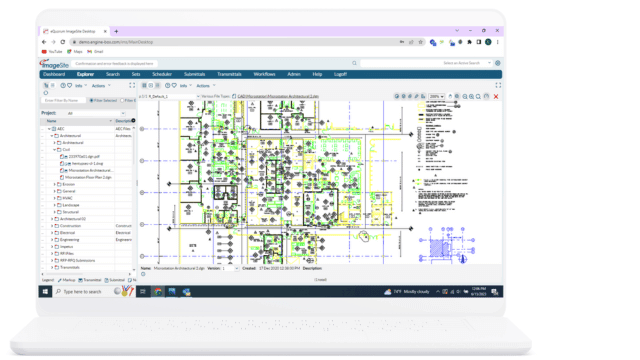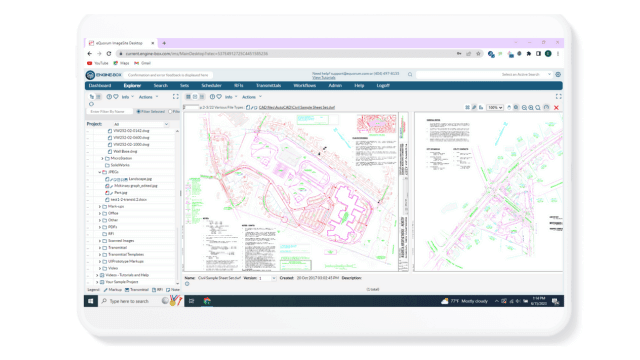Eliminating Bottlenecks Through Engineering Workflow Management
Eliminating Bottlenecks Through Engineering Workflow Management
In workflow management, a bottleneck is a situation causing a delay in a process or system. Similar to a traffic jam, it prevents actions and documents from progressing within the engineering workflow. Bottlenecks are typically caused by inefficiencies in a workflow’s configuration. While many managers are aware that the bottlenecks exist, they can be extremely difficult to pinpoint using traditional methods. A workflow and document management system can help organizations detect these bottlenecks, so companies can rethink their workflows and create more efficient processes.
Types of Bottlenecks
Bottlenecks can be both short-term and long-term; however, there is a rigid dichotomy between the two. Short-term bottlenecks are often inevitable and are caused by unavoidable instances, such as temporary absences, training times, and miscommunication. Long-term bottlenecks, on the other hand, are systemic and can be much more devastating to an organization. They present significant challenges for many organizations and are more likely to occur as a result of inefficient workflows and managerial processes. While many employees may be working at full capacity, their current systems may actually hinder productivity and consequently impact the bottom line, and can do so for a long time if not corrected.
ImageSite’s Workflow+ module is the perfect tool for designing and optimizing workflows, such as those used by engineers and external collaborators. Organizations can automate document actions at each step in the workflow and easily detect bottlenecks and data silos as they occur. Not only do administrators have the ability to create and visualize company workflows in ImageSite, but they can make changes at any point in time and effortlessly rectify errors in their processes.
Eliminating bottlenecks in an engineering workflow start with reviewing audit trails to analyze bottlenecks then optimizing bottlenecks to improve key metrics that directly elevate your bottom line.

The Discipline of Workflow Schedule Management
Business operations seem more chaotic than ever. The economic swings seem bigger; the labor pool is tighter, more diverse, and more geographically dispersed; the amount of information is enormous; and at the end of the day, management has just become harder. Trying to get your arms around all that’s going on and ensuring the organization is focused on getting the tasks done is now more complex and daunting. Add pandemics, supply chain disruptions, geopolitical uncertainty, and now even historical inflation.
What is a manager to do?
Audit Trails to Analyze Bottlenecks
The system also creates audit trails of all workflow and document actions within the system, ensuring no nefarious actions are taken and all projects are completed on time. Audit trails provide records of all actions, including the frequency in which documents are opened, viewed, downloaded, or printed. It’s an easy way to understand how users are interacting with the system and who is accessing each file.
Audit trails not only help organizations detect long-term bottlenecks but also help organizations manage audit compliance, making it easy to respond to regulatory requirements and e-discovery requests. Companies seeking certification can also use audit trails to comply with standards, including by NIST, ISO, DFARS, ITAR, and NERC/CIP.
To better understand timelines in a workflow, organizations can utilize ImageSite to create a clear understanding of the workflow's step-by-step progression. With the Workflow+ module, managers can visualize the progress of a workflow by displaying progress as a percentage at each step. It's up to the workflow creator (typically the administrator) to determine the status of a project at workflow steps so team members should be included, as their input may be valuable for creating realistic and achievable work effort accruals and deadlines.
Optimizing Bottlenecks
Reducing the number of bottlenecks in a workflow significantly improves processes by enabling organizations to complete workflow steps more quickly. With optimized workflows, organizations can expect to see improvements in project turnover, enabling organizations to achieve a faster return on their investments and improvement in their bottom line. It also helps companies create a less stressful environment, which is proven to improve productivity throughout their workforce.
Additional EDMS Features
Our EDMS solutions
ImageSite and EngineBox are eQuorum’s robust workflow and document management solutions, created to help workers manage their essential workflows while maintaining complete control over their engineering files and documents. Not only do they provide a secure collaboration site for workers, but they also help organizations manage document distribution with third parties like vendors, contractors, and customers. Both systems are offered at a competitive price, enabling organizations to get a quick return on their investment by providing the features and functionality needed to help organizations improve efficiency, productivity, and collaboration. Companies can choose from concurrent user subscriptions or named user subscriptions, ensuring organizations have subscription options that make sense for their business.

ImageSite®
Our single source engineering workflow and document management system. Built in HTML5 so there is no software to deploy to client computers or mobile apps to download. Offered as an On-premise or Private Cloud system.
EngineBox™
EngineBox is a cloud based workflow and document management version of ImageSite that resides outside the corporate network.
Our EDMS solutions
ImageSite and EngineBox are eQuorum’s robust workflow and document management solutions, created to help workers manage their essential workflows while maintaining complete control over their engineering files and documents. Not only do they provide a secure collaboration site for workers, but they also help organizations manage document distribution with third parties like vendors, contractors, and customers. Both systems are offered at a competitive price, enabling organizations to get a quick return on their investment by providing the features and functionality needed to help organizations improve efficiency, productivity, and collaboration. Companies can choose from concurrent user subscriptions or named user subscriptions, ensuring organizations have subscription options that make sense for their business.

EngineBox™
EngineBox is a cloud based workflow and document management version of ImageSite that resides outside the corporate network.
The eQuorum Customer Promise
In 2005, eQuorum developed the first all browser-based EDMS. The system, although for on-premise use, was still created to remove client software and JAVA from user computers and allow users to have a single viewer based on the simple navigation functionality of browsers. Today, eQuorum provides that same application in a private Cloud or a SaaS Cloud option. We can do this because we are, and have always been, browser-based, understanding the enhanced speed, security, and usability of this technology.
With the abundance of document management systems on the market today, there’s no doubt that choosing the right Cloud document management software can be a difficult decision. eQuorum is here to provide a comprehensive, powerful, and most importantly – affordable Cloud document management solution. We believe in providing real value to our customers by eliminating unnecessary costs, providing industry-leading functionality, and equipping your team with the right tools using cutting edge technology to bring your products to market faster.
eQuorum®
We specialize in engineering workflow and document management. Our comprehensive, yet easy-to-use software provides the solution to manage data from design to manufacturing and production, to sales, support and administration.